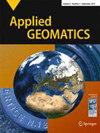1973-2020年50年阿富汗喀布尔土地利用和土地覆盖变化:影响城市动态的驱动因素
IF 2.3
Q2 REMOTE SENSING
引用次数: 0
摘要
本研究使用陆地卫星和哨兵卫星图像作为主要分析工具,深入研究了喀布尔城市扩张的模式。我们将土地利用和土地覆盖(LULC)分为五个不同的类别:水体、植被、荒地、贫瘠的岩石地形和建筑物。使用ERDAS Imagine v.2015和ArcGIS 10.8软件进行必要的数据处理和分析。我们的主要目标是仔细研究在五个离散的十年中LULC的变化。此外,我们追踪了1973年至2020年喀布尔建成区的长期演变。分类卫星图像显示了所有类别的重大变化。例如,建设用地面积从2013年的29.91%下降到2020年的23.84%,同期的荒地面积从33.3%下降到28.4%。相反,岩石贫瘠地形的比例从2013年的22.89%上升到2020年的29.97%。水体和植被利用类型变化不大,但变化显著。水体比例从2003年的2.51%下降到2013年的1.30%,植被土地利用程度从2003年的13.61%下降到2013年的12.6%。我们的研究揭示了随着时间的推移不断变化的土地利用模式,在特定时期,荒地增加,植被面积略有增加。这些调查结果强调了喀布尔城市景观多年来的动态变化,对城市规划和可持续性产生了重大影响。本文章由计算机程序翻译,如有差异,请以英文原文为准。
Land Use and Land Cover Changes in Kabul, Afghanistan Focusing on the Drivers Impacting Urban Dynamics during Five Decades 1973–2020
This study delves into the patterns of urban expansion in Kabul, using Landsat and Sentinel satellite imagery as primary tools for analysis. We classified land use and land cover (LULC) into five distinct categories: water bodies, vegetation, barren land, barren rocky terrain, and buildings. The necessary data processing and analysis was conducted using ERDAS Imagine v.2015 and ArcGIS 10.8 software. Our main objective was to scrutinize changes in LULC across five discrete decades. Additionally, we traced the long-term evolution of built-up areas in Kabul from 1973 to 2020. The classified satellite images revealed significant changes across all categories. For instance, the area of built-up land reduced from 29.91% in 2013 to 23.84% in 2020, while barren land saw a decrease from 33.3% to 28.4% over the same period. Conversely, the proportion of barren rocky terrain exhibited an increase from 22.89% in 2013 to 29.97% in 2020. Minor yet notable shifts were observed in the categories of water bodies and vegetated land use. The percentage of water bodies shrank from 2.51% in 2003 to 1.30% in 2013, and the extent of vegetated land use showed a decline from 13.61% in 2003 to 12.6% in 2013. Our study unveiled evolving land use patterns over time, with specific periods recording an increase in barren land and a slight rise in vegetated areas. These findings underscored the dynamic transformation of Kabul’s urban landscape over the years, with significant implications for urban planning and sustainability.
求助全文
通过发布文献求助,成功后即可免费获取论文全文。
去求助
来源期刊

Applied Geomatics
REMOTE SENSING-
CiteScore
5.40
自引率
3.70%
发文量
61
期刊介绍:
Applied Geomatics (AGMJ) is the official journal of SIFET the Italian Society of Photogrammetry and Topography and covers all aspects and information on scientific and technical advances in the geomatics sciences. The Journal publishes innovative contributions in geomatics applications ranging from the integration of instruments, methodologies and technologies and their use in the environmental sciences, engineering and other natural sciences.
The areas of interest include many research fields such as: remote sensing, close range and videometric photogrammetry, image analysis, digital mapping, land and geographic information systems, geographic information science, integrated geodesy, spatial data analysis, heritage recording; network adjustment and numerical processes. Furthermore, Applied Geomatics is open to articles from all areas of deformation measurements and analysis, structural engineering, mechanical engineering and all trends in earth and planetary survey science and space technology. The Journal also contains notices of conferences and international workshops, industry news, and information on new products. It provides a useful forum for professional and academic scientists involved in geomatics science and technology.
Information on Open Research Funding and Support may be found here: https://www.springernature.com/gp/open-research/institutional-agreements
 求助内容:
求助内容: 应助结果提醒方式:
应助结果提醒方式:


